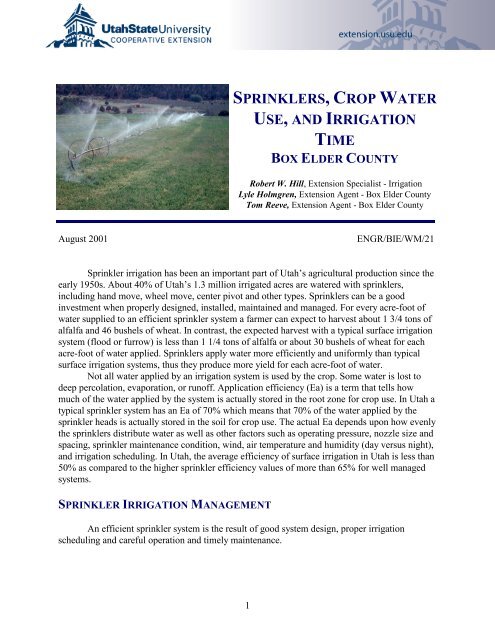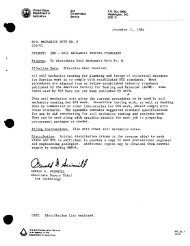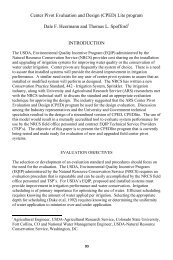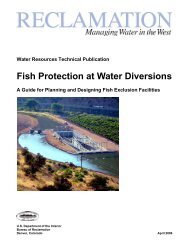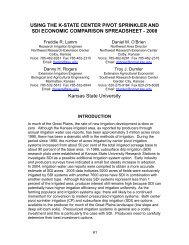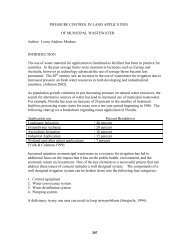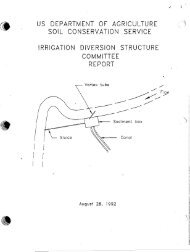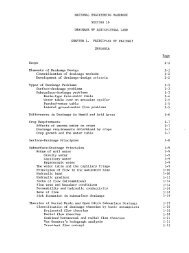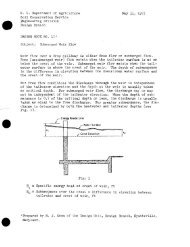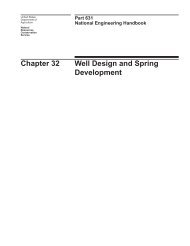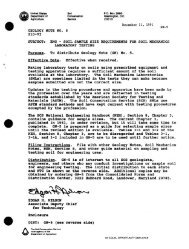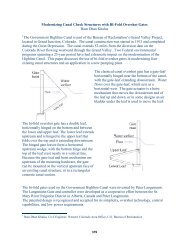Sprinklers, Crop Water Use, and Irrigation TIme, Box Elder County
Sprinklers, Crop Water Use, and Irrigation TIme, Box Elder County
Sprinklers, Crop Water Use, and Irrigation TIme, Box Elder County
Create successful ePaper yourself
Turn your PDF publications into a flip-book with our unique Google optimized e-Paper software.
SPRINKLERS, CROP WATERUSE, AND IRRIGATIONTIMEBOX ELDER COUNTYRobert W. Hill, Extension Specialist - <strong>Irrigation</strong>Lyle Holmgren, Extension Agent - <strong>Box</strong> <strong>Elder</strong> <strong>County</strong>Tom Reeve, Extension Agent - <strong>Box</strong> <strong>Elder</strong> <strong>County</strong>August 2001ENGR/BIE/WM/21Sprinkler irrigation has been an important part of Utah’s agricultural production since theearly 1950s. About 40% of Utah’s 1.3 million irrigated acres are watered with sprinklers,including h<strong>and</strong> move, wheel move, center pivot <strong>and</strong> other types. <strong>Sprinklers</strong> can be a goodinvestment when properly designed, installed, maintained <strong>and</strong> managed. For every acre-foot ofwater supplied to an efficient sprinkler system a farmer can expect to harvest about 1 3/4 tons ofalfalfa <strong>and</strong> 46 bushels of wheat. In contrast, the expected harvest with a typical surface irrigationsystem (flood or furrow) is less than 1 1/4 tons of alfalfa or about 30 bushels of wheat for eachacre-foot of water applied. <strong>Sprinklers</strong> apply water more efficiently <strong>and</strong> uniformly than typicalsurface irrigation systems, thus they produce more yield for each acre-foot of water.Not all water applied by an irrigation system is used by the crop. Some water is lost todeep percolation, evaporation, or runoff. Application efficiency (Ea) is a term that tells howmuch of the water applied by the system is actually stored in the root zone for crop use. In Utah atypical sprinkler system has an Ea of 70% which means that 70% of the water applied by thesprinkler heads is actually stored in the soil for crop use. The actual Ea depends upon how evenlythe sprinklers distribute water as well as other factors such as operating pressure, nozzle size <strong>and</strong>spacing, sprinkler maintenance condition, wind, air temperature <strong>and</strong> humidity (day versus night),<strong>and</strong> irrigation scheduling. In Utah, the average efficiency of surface irrigation in Utah is less than50% as compared to the higher sprinkler efficiency values of more than 65% for well managedsystems.SPRINKLER IRRIGATION MANAGEMENTAn efficient sprinkler system is the result of good system design, proper irrigationscheduling <strong>and</strong> careful operation <strong>and</strong> timely maintenance.1
DESIGNA well designed sprinkler system applies water uniformly to the soil surface, <strong>and</strong> iscapable of applying enough water to meet the peak dem<strong>and</strong>s of the crop without producingexcess runoff. Good design considers such factors as pressure; nozzle size <strong>and</strong> spacing; wind, airtemperature <strong>and</strong> humidity (day versus night); soil intake rate; crop rooting depth <strong>and</strong> water userates.The flow rate from a sprinkler nozzle depends upon nozzle size <strong>and</strong> water pressure. Flowrates for selected nozzle sizes <strong>and</strong> pressures are given in Table 1. Typical sprinkler flow ratesmay vary from 4 gallons per minute (gpm) from a 5/32-inch nozzle at 30 pounds pressure to over11 gpm from a 7/32-inch nozzle at 70 pounds pressure. The nozzle size is usually stamped on theside of the nozzle. Wheelmove systems typically have 3/16-inch nozzles.On sloping fields there may be considerable pressure differences between sprinkler headson high <strong>and</strong> low ends of the line. In this situation, flow control nozzles may be used to improvethe uniformity of water application. Flow control nozzles apply water at nearly the same ratewhen operated within the rated pressure range of the nozzle.Precipitation Rate (How hard is it raining?):The Precipitation Rate (Pr) is the rate at which water is delivered from the nozzle,averaged as inches per hour, over the area covered by one nozzle. It is important to consider thePr when designing a sprinkler system, since water will run off if applied faster than the soil canabsorb it. Precipitation rate can be calculated using the following formula:Pr (inches/hr) = 96.3 × nozzle flow rate (gpm)/area covered (ft 2 ) (1)Table 1. Sprinkler Pressure <strong>and</strong> Flow Rate.NozzleNozzle Pressure, psisize 30 40 50 60 70InchNozzle flow rate, gallons per minute (gpm)5/32 3.9 4.5 5.0 5.4 5.811/64 4.7 5.4 6.0 6.6 7.13/16 5.5 6.3 7.0 7.7 8.313/64 6.4 7.4 8.2 9.0 9.77/32 7.4 8.6 9.6 10.5 11.3Note: Flow rates are for agricultural sprinkler heads with brass nozzles. Sprinkler nozzle flowrate is proportional to the square root of the water pressure at the base of the nozzle thus doublingthe pressure does not double the flow rate.2
For irrigation scheduling to be most useful at a specific location, the following should be done:1. Evaluate the irrigation system. Determine application depth, efficiency, <strong>and</strong>operating capabilities <strong>and</strong> constraints.2. Select an appropriate irrigation scheduling method.3. Monitor performance at intervals during the growing season.4. Perform a post-season evaluation <strong>and</strong> determine changes for next year.OPERATION AND MAINTENANCETo realize the full benefit of the sprinkler system, it must be operated according to design<strong>and</strong> properly maintained throughout the irrigation season. This may involve special operatingtechniques such as using an offset hose or alternating between day <strong>and</strong> night on successiveirrigation cycles to improve distribution uniformity. Where pressure differences within asprinkler system result in low uniformity of water application, special hardware such as flowcontrol nozzles or pressure regulators may be required.An audit or evaluation of the irrigation system is recommended if you suspect that thesystem is not as efficient as it should be. An audit determines application depth, distributionuniformity, <strong>and</strong> hydraulic performance of the supply system. If a pump is used, it is tested todetermine fuel or energy use efficiency. An audit may also identify steps to improve systemoperation <strong>and</strong> maintenance.Good operation also includes matching the set time (or rotation time with a center pivot)with the applied irrigation water depth <strong>and</strong> application rate to maximize the fraction of waterstored in the root zone. Field irrigation (application) efficiency is the ratio of water stored in theroot zone divided by the water delivered to the field. For example, if 50 acre inches of water aredelivered to a 10 acre field during an irrigation <strong>and</strong> 30 acre inches are stored in the root zone thenthe application efficiency (Ea) is 60% (60 = 100 × 30/50). If a field is under-irrigated, a highirrigation efficiency could result with a low uniformity. Conversely, an over-irrigated field willhave a low irrigation efficiency, regardless of the high uniformity, because of the deeppercolation. Thus, a knowledge of the soil moisture content prior to irrigation is essential tomaintaining a high application efficiency while providing for optimum crop water use <strong>and</strong>growth.CROP WATER USEThe single most important factor influencing plant growth <strong>and</strong> crop yields is soil wateravailability. A good underst<strong>and</strong>ing of how water influences crop growth is essential for goodwater management. <strong>Water</strong> is the most massive of the inputs to crop yield. It takes 120 pounds ofwater (evapotranspiration only) to produce 1 pound of potatoes, 560 pounds of water for 1 poundof alfalfa hay <strong>and</strong> 790 pounds of water for 1 pound of wheat.Soil water availability is affected by infiltrated irrigation water <strong>and</strong> rainfall, drainage <strong>and</strong>evapotranspiration. The crop irrigation requirement, or evapotranspiration (Et), is thecombination of transpiration from plant leaves plus evaporation from adjacent soil surfaces.While crop Et can be measured, it is most often estimated with equations from weather datacollected locally. Estimated average monthly crop water use (Et) for alfalfa, pasture, spring grain,<strong>and</strong> turf in Corinne, Grouse Creek, <strong>and</strong> Snowville are given in Table 3. Seasonal Et is higher inCorinne for alfalfa, pasture, <strong>and</strong> turf. However, seasonal total Et for spring grain is slightly higherin Snowville.5
Assuming that the soil water depletion is completely replenished with each irrigation, theirrigation requirement is equal to Et minus effective rainfall. As a general rule, field crops shouldbe irrigated whenever the soil water depletion approaches 50% of the available water in the rootzone (see Appendix). This minimizes crop stress <strong>and</strong> keeps yields high. In the peak crop wateruse period in an arid area, the occurrence of rain is often neglected in determining an irrigationschedule.Table 3. Monthly <strong>Crop</strong> Evapotranspiration for Corinne, Grouse Creek, <strong>and</strong> Snowville.Thirty year average for period 1961-1990.SeasonSite Mar Apr May Jun Jul Aug Sep Oct TotalAlfalfa <strong>Water</strong> <strong>Use</strong>, InchesCorinne 0.19 2.89 5.33 7.78 7.12 6.46 4.70 2.43 36.89Grouse Creek 0.21 5.39 6.14 7.78 6.36 3.70 0.50 30.08Snowville 0.54 5.67 6.76 7.84 7.54 3.38 1.04 32.78Pasture <strong>Water</strong> <strong>Use</strong>, InchesCorinne 0.04 1.86 4.20 5.52 6.27 5.52 3.68 1.73 28.83Grouse Creek 0.39 3.52 5.38 6.26 5.16 2.76 0.33 23.79Snowville 0.98 3.65 5.70 6.30 5.19 2.80 0.71 25.33Sp Grain <strong>Water</strong> <strong>Use</strong>, InchesCorinne 1.00 5.32 8.50 6.43 21.25Grouse Creek 0.14 2.43 7.96 9.40 2.62 22.56Snowville 0.35 3.34 8.71 8.90 1.44 22.75Turf <strong>Water</strong> <strong>Use</strong>, InchesCorinne 0.27 2.10 3.63 4.76 5.40 4.76 3.17 1.69 25.78Grouse Creek 0.72 3.22 4.64 5.39 4.44 2.38 0.28 21.06Snowville 1.41 3.32 4.91 5.43 4.48 2.42 0.61 22.58Adapted from: Consumptive <strong>Use</strong> of Irrigated <strong>Crop</strong>s in Utah, Utah Agricultural Experiment StationResearch Report No. 145. Oct. 1994.CALCULATING AN IRRIGATION INTERVALThe information needed to determine the interval between irrigations is available soilwater in the root zone, crop water use (Et) rate (inches per day), <strong>and</strong> allowable soil waterdepletion at irrigation. Conversely, the irrigation system applied water depth (if fixed for allirrigations) could be used in place of the allowable depletion.Example A: Simple <strong>Irrigation</strong> Calendar. Determine the irrigation interval <strong>and</strong> applicationdepth for alfalfa on s<strong>and</strong>y loam soil at Snowville. <strong>Use</strong> July Et <strong>and</strong> a root depth of 5 ft. Irrigatewhen one half of the available soil water has been depleted, i.e., when the management alloweddepletion (MAD) is 50%.6
From Table 3, July Alfalfa Et at Snowville is 7.84 inchesAverage daily Et rate = 7.84 inches/31 days = 0.25 inches/day.Soil water holding capacity (s<strong>and</strong>y loam) is 1.5 inches/ft (from Appendix).Root zone available water = 5 ft × 1.5 inches of water/ft = 7.5 inches of water.At a MAD of 50% depletion between irrigations, the irrigation amount is 7.5 × .5 = 3.8inches for each irrigation.<strong>Irrigation</strong> interval = <strong>Irrigation</strong> amount/daily Et rate = 3.8 inches/0.25 inches per day –15days.Summary: Irrigate every 15 days, storing 3.8 inches of irrigation water in the root zone.Example B. Alternate irrigation interval if wheel move sprinklers are moved twice perday. Assume 3/16 inch nozzles at 50 psi <strong>and</strong> 40 ft by 60 ft spacing (see examples with equations1, 2, <strong>and</strong> 3 previously), <strong>and</strong> the same situation as in Example A above.The net irrigation is 2.3 inches stored in the soil (2.3 inches = an application rate of 0.20inches per hour x 11.5 hours per set).The irrigation interval = 2.3 inches/0.25 inches per day = about 9 days.Summary: Irrigate every 9 days, storing 2.3 inches of irrigation water in the root zone.Both of these examples use the average daily Et rate for the month to illustrate thecalculations. If a real time soil water budget method of irrigation scheduling were used, it wouldaccount for the day to day variations in Et <strong>and</strong> rain. This would result in a varying the irrigationinterval as needed.SUMMARYGood sprinkle irrigation requires:• Underst<strong>and</strong>ing of Soil-<strong>Water</strong>-Plant Relationships• <strong>Irrigation</strong> timing <strong>and</strong> amount depends on soil water holding capacity, weather, <strong>and</strong> cropgrowth progress.• Adequate Design <strong>and</strong> Installation• Proper Operation <strong>and</strong> Maintenance• Dedication <strong>and</strong> Commitment of Resources to Manage (i.e., the WILL to manage)ACKNOWLEDGMENTSThis fact sheet originated with a request from Marlon Winger (Carbon <strong>County</strong>) <strong>and</strong>Dennis Worwood (Emery <strong>County</strong>). Their contribution to the first of these county specific factsheets is appreciated. This fact sheet was peer reviewed by Howard Neibling, University ofIdaho <strong>Irrigation</strong> Specialist; Rich Koenig, Utah State University Soil Fertility Specialist; SteveRogers, USDA - NRCS Area Engineer; <strong>and</strong> Utah Extension Agents: James Barnhill, DeanMiner, <strong>and</strong> Shawn Olsen. Their time <strong>and</strong> valuable suggestions are greatly appreciated. The wordprocessing <strong>and</strong> publication skills of Melanie Christoffersen <strong>and</strong> Donna Falkenborg are alsogratefully acknowledged.7
APPENDIXAvailable <strong>Water</strong>-holding Capacity of Soils Typical <strong>Crop</strong> Rooting DepthsInches of availablewater per foot Permeability rate 1 Typical active rootSoil Texture of moist soil Inches/Hour <strong>Crop</strong> Zone depth, feetS<strong>and</strong>s <strong>and</strong> fine s<strong>and</strong>s 0.5 - 0.75 1.0 - 10 Alfalfa 5Very fine s<strong>and</strong>s, loamy s<strong>and</strong> .8 - 1.0 1.0 - 3 Corn 4 - 5S<strong>and</strong>y Loam 1.2 - 1.5 0.5 - 3 Small Grains 3 - 4Loam 1.9 - 2.0 0.3 - 0.8 Dry Beans 3Silt loam, silt 2.0 0.2 - 0.4 Pasture 1 ½ - 2 ½Silty clay loam 1.9 - 2.0 0.01 - 0.2 Potatoes 1 ½ - 2 ½S<strong>and</strong>y clay loam, Clay loam 1.7 - 2.0 0.1 - 0.6 Turf 1 - 2Vegetables 1 ½ - 3Note: Allowable depletion to avoid crop water stress is usually about 50% of available waterholding capacity for most field crops.1 Normal ranges. Intake rates vary greatly with soil structure <strong>and</strong> structural stability.The web site address for “Consumptive <strong>Use</strong> of Irrigated <strong>Crop</strong>s in Utah,” UAES Research Report#145, <strong>and</strong> the data tables used in Table 3 herein is found by going to the Utah Division of <strong>Water</strong>Rights home page at: http://nrwrtl.nr.state.ut.us/BIBLIOGRAPHYThen select “Publications” <strong>and</strong> then select “Consumptive <strong>Use</strong> Tables”Hill, R.W. 1991. <strong>Irrigation</strong> Scheduling. Chapter 12 in Modeling Plant <strong>and</strong> Soil Systems, John Hanks <strong>and</strong>J.T. Ritchie (eds.), American Society of Agronomy, Inc., <strong>Crop</strong> Science Society of America, Inc.,Soil Science Society of America, Inc., Madison, WI. 491-509.Hill, R.W. 1994. Consumptive <strong>Use</strong> of Irrigated <strong>Crop</strong>s in Utah. Utah Agr. Exp. Stn. Res. Report No. 145,Utah State University, Logan, UT. Oct. 370 pp. Revised <strong>and</strong> reprinted Feb. 1998.Hill, R.W. <strong>and</strong> R.G. Allen. 1996. Simple <strong>Irrigation</strong> Scheduling Calendars. Journal <strong>Irrigation</strong> <strong>and</strong>Drainage Division. ASCE. 122:2, March/April.Hill, R.W. , R.J. Hanks, <strong>and</strong> J.L. Wright. 1984. <strong>Crop</strong> Yield Models Adapted to <strong>Irrigation</strong> SchedulingPrograms. Utah Agr. Exp. Stn. Res. Report 99.For additional reading/resource material see:Larsen, D.C. <strong>and</strong> T.S. Longley. “Nozzle Management <strong>and</strong> Leak Prevention for Sprinkler <strong>Irrigation</strong>.”Current Info. Series No. 569. University of Idaho Coop. Extension Service, Moscow, ID 83843.MSU Agronomy Notes Series numbers 44, 47, 49, 53, 102, <strong>and</strong> 122. J.W. Bauder. Soil <strong>and</strong> <strong>Water</strong>Specialist; Plant, Soils <strong>and</strong> Environmental Science Department, Montana State University,8
Bozeman, MT 59717. Telephone (406) 944-5685; email: jbauder@montana.edu.Pacific Northwest Extension Publication, PNW Series numbers 286-292. Jan. 1986. Available fromUniversity of Idaho Cooperative Extension Service, Moscow, ID 83843. Titles in this seriesinclude: Pumping Plant Efficiencies, Offsets for Stationary Sprinkler Systems, <strong>Irrigation</strong> RunoffControl Strategies, <strong>Irrigation</strong> Scheduling, Converting Sprinkler Systems to Lower Pressure,Sizing <strong>Irrigation</strong> Mainlines <strong>and</strong> Fittings, Electrical Dem<strong>and</strong> Charges-How to Keep them Low,Extending Electric Motor Life.Additional information on wheel move sprinkler management is available on the Utah State Universityweb site at:http://extension.usu.eduSelect “Publications” <strong>and</strong> then select “<strong>Irrigation</strong> Engineering”BIE/WM-05 “Maintenance of Wheelmove <strong>Irrigation</strong> Systems”BIE/WM-08 “Wheelmove Sprinkler <strong>Irrigation</strong> Operation <strong>and</strong> Management”WHERE CAN YOU GET HELP?Utah State University - Extension ServiceUSU Extension, Biological USU Extension Office USU Extension Office<strong>and</strong> <strong>Irrigation</strong> Engineering Brigham City Office Tremonton Office4105 Old Main Hill 1 South Main P.O. <strong>Box</strong> 206Logan, UT 84322-4105 Brigham City, UT 84302 Tremonton, UT 84337bobh@ext.usu.edu tomr@ext.usu.edu lyleh@ext.usu.edu(435) 797-2791 (435) 734-3387 (435) 257-5447Robert W. Hill, Extension <strong>Irrigation</strong> SpecialistBiological <strong>and</strong> <strong>Irrigation</strong> Engineering DepartmentUtah State University, Logan, UT 84322-4105Tom Reeve, <strong>County</strong> Agent - <strong>Box</strong> <strong>Elder</strong> <strong>County</strong>Utah State University, Logan, UT 84322Lyle Holmgren, <strong>County</strong> Agent - <strong>Box</strong> <strong>Elder</strong> <strong>County</strong>Utah State University, Logan, Ut 84322Utah State University Extension does not discriminate on the basis of race, color, national origin,gender, religion, age, disability, political beliefs, sexual orientation, or marital or family status in employment orprogram delivery.Issued in furtherance of Cooperative Extension work, Acts of May 8 <strong>and</strong> June 30, 1914, in cooperationwith the U.S. Department of Agriculture, Jack M. Payne, Vice-President <strong>and</strong> Director, Cooperative ExtensionService, Utah State University, Logan, Utah. (EP/08-2001/DF)9


